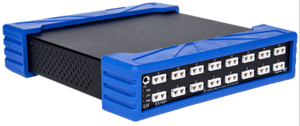Power over Ethernet (POE) is a technology that enables network cables to carry the electrical power required by the end devices to which they are connected. One of the features that makes the EX1401 16-Channel Isolated Thermocouple and Voltage Measurement Instrument so useful is that can derive is power from Ethernet ports that support POE.

There are two types of POE ports: POE (IEEE 802.3af) and POE+ (IEEE 802.3at). POE ports supply up to 15.4 watts over Cat5 cabling, while POE+ ports can supply 25.5 watts. In most applications, the EX1401 requires a POE+ port to function properly.
Powering an EX1401 with POE offers several advantages:
- Reduced wiring. Because POE uses network wiring infrastructure already in place, there’s no need to purchase special cables/connectors. Commercially available CAT-5e (or higher grade) cable can be used to power up the instrument. Similarly, there’s no need to hire a separate electrical contractor for setting up electrical power ports near the test area.
- Flexibility: Because they aren’t tethered to an electrical outlet, distributed data acquisition systems and wireless access points can be located anywhere they are needed and repositioned easily if required.
- Reduced installation time. Installing networking infrastructure is typically easier and less costly than installing wall power sockets. This is especially true for temporary setups.
- Safety: Because the voltages involved in PoE are much lower than AC mains power voltage levels, PoE is quite safe for untrained operators.
- Reliability: The devices that are pumping the power into the network can be easily backed up by a centralized uninterruptible power supply (UPS). This eliminates the need for individual UPS connections at each installation location, reducing cost.
- Reboot Convenience: When the instrument must be rebooted/power cycled, it can be done without making physical contact with the instrument. This is done by switching off the power to the selected instrument from the Ethernet switch itself programmatically.
Here are some frequently-asked questions about using the EX1401 with POE:
Q: What's the longest cable that I can use to power PoE/PoE+ instruments?
A. The maximum cable length is 100 meters.
Q. What would happen if I plugged an EX1401 16-channel isolated thermocouple and voltage measurement instrument into a PoE-only port?
A. Because the maximum input power required by the EX1401 is 15 W, it may or may not work with a POE. Port. To ensure stable operation, we recommend powering it only with PoE+ ports.
Q. Can I operate an EX1401 without PoE? Is there any alternate ways of powering it?
A. You can power the EX1401 using any clean DC power source with an output voltage between 11 VDC and 30 VDC.
Q. Can I connect PoE+ devices and instruments and non-PoE devices (traditional LXI) devices to the same PoE+ enabled switch?
A. Yes. When you connect a traditional LXI device to a POE+-enabled switch, the switch behaves like a regular network switch.
VTI Instruments delivers precision modular instrumentation and systems for electronic signal distribution, acquisition, and monitoring. For more information about the EX1401 and other VTI products, contact VTI Instruments phone 949.955.1894 or send an email to vti.sales@ametek.com.
